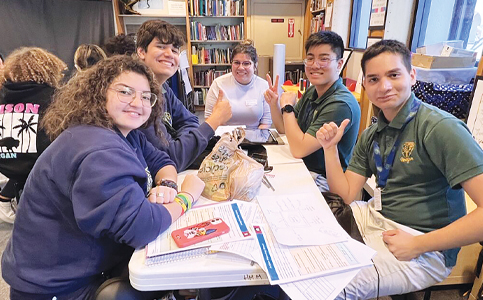Coup’s Notebook Vol. 12: Bam Adebayo Returns Along With Miami’s True Defense, The Fourth Quarter Of Doom And Erik Spoelstra’s High-Class Problems

The Miami HEAT are 29-16, percentage points behind the top seed in the Eastern Conference, and have the No. 5 Net Rating in the NBA at plus-4.7. Here’s what we’ve been noting and noticing.
BAM IS BACK, SO IS MIAMI’S DEFENSE
From December 1 to January 15, the 22 game stretch that Bam Adebayo was out after undergoing surgery on his left thumb, the Miami HEAT were the No. 12 defense in the NBA with a Defensive Rating of 109.8 – a number that would rank No. 19 in the league for the entire season.
In a vacuum you may scoff at that ranking, or at least find it unremarkable. Within the context of all of the injuries and protocols that the HEAT endured, including Jimmy Butler also missing 14 of those 22 games, it was a tremendous achievement which required a gargantuan effort from all involved. Erik Spoelstra pushed every defensive button at his disposal, Omer Yurtseven slowly learned how to navigate the possession-to-possession intricacies of man-to-man, Gabe Vincent and Caleb Martin proved themselves as perimeter stoppers three times over and P.J. Tucker was a monster throughout.
The results may not have been elite, but with the offense holding serve thanks to one of the best shooting stretches in franchise history, the results were a step above good enough. They were also inherently temporary.
With Adebayo back, Miami’s defense can get back to what it’s truly meant to be.
Until Adebayo went down with the injury, the HEAT were tied with the Boston Celtics as the most switch-heavy team in the league, switching just over 29 screens per 100 possessions. They were really good at it, too, allowing just 0.89 points-per-possession when switching.
During the six weeks that he was out, that number was down to 19 per 100. Still high within the league context – Tucker, after all, is one of the best switch defenders of the past decade – but hardly prolific. Spoelstra went with a ton of zone in the first couple of weeks as the team adjusted, then dialed up large portions of blitzing, showing and drop coverage depending on the matchup of the evening. Miami’s defense allowed 0.97 points-per-possession against pick-and-rolls during that time.
In the two games since Adebayo’s return, everything is back to normal as though someone pulled a lever. Miami has switched 29 pick-and-rolls per 100 against Toronto and Portland, allowing 0.79 points-per-possession when doing so.
“[He] enables us to switch pick-and-rolls, instead of having to trap and make everybody rotate,” Dewayne Dedmon said of Adebayo. “He’s the best defender 1-through-5 that I’ve seen in a while.”
It was an impressive run while it needed to be, Spoelstra showing his night-to-night scheme flexibility as the team adapted and overcame. But this team, with Adebayo and Tucker and Butler and Kyle Lowry, was always destined to be about the switch. Good thing, too, given that we have years of evidence now that one of the prerequisites for postseason success is the ability to flatten out elite offenses by blowing up their actions before they even happen.
Speaking of which.
THE FOURTH QUARTER OF DOOM
Through three quarters on Wednesday, the Portland Trail Blazers had an Offensive Rating of 111.1. Above their season average and, considering the absences of Damian Lillard and Norman Powell, within the realm of reasonable expectations that would allow them to steal a game on the road.
In the fourth quarter on Wednesday, the Blazers had an Offensive Rating of 52.2. One of the ten worst fourth quarters any team has had this season and Miami’s best defensive performance in the final period since 2018-19. With Lowry and Butler (who had been ejected in the second quarter) on the sidelines, the HEAT had their best defensive fourth quarter of the Butler era.
“I bet that was my boss’s favorite fourth quarter of the season,” Spoelstra said, referring to Pat Riley.
How did they do it? Switching, help and pristine defensive spacing. Let’s take a look at three possessions during the most crucial minutes, when Miami stretched a one-possession game to three.
Caleb Martin picks up full court, because of course he does. He is the fly in the ointment for opposing point guards, having pestered and annoyed the likes of Steph Curry, Chris Paul and Trae Young over the past two weeks. Tucker has been sticking to CJ McCollum like glue all quarter, so when McCollum catches at the logo he doesn’t have much interest in an isolation and instead calls for a pick-and-roll.
Easy switch for Adebayo. McCollum doesn’t even try going anywhere, kicking it to Anfernee Simons who settles for the quick three. Watch Martin’s technique on the contest. He stays in his stance to be ready for the drive, keeps his hand high, and when it comes time to eat into Simons’ airspace as the shot goes up, he stops on a dime and skinnies up so as not to create any undue contact. Simons can make that shot, but you can’t ask for much more.
Another full-court pick up from Martin. The screens leads to an easy switch for Gabe Vincent. Watch Martin’s spacing as Simons dribbles up the right slot, Martin sitting at the top of the circle. That’s Miami’s defensive spacing all the way, constantly making the ballhandler compute and calculate the risk-reward scenario of trying to attack the driving lane.
Simons makes the easy pass to Robert Covington, Martin recovers with a helpful stunt from Tucker, and another switch later Martin is back on McCollum. There’s seven on the shot clock and the ball hasn’t even approached the three-point line. McCollum goes into isolation mode.
First, watch Tucker here as he lingers in help position while Adebayo rotates over in the backline to manage the passing lanes for both his and Tucker’s man. McCollum has nowhere to go on Tucker’s side – this is where being a smaller guard is trouble against Miami, as its much tougher for them to hit the open players on the weakside that the HEAT tend to leave open – and when he goes to cross over to the right, there’s Vincent with the help. Goodnight, sweet clutch possession.
Martin again annoys Simons, and this time the clock is at 15 before Simons is even trying to make a forward pass. Ball to Nurkic, Martin stays locked in on Simons to prevent a possible handoff, and Nurkic looks cross-court for McCollum.
McCollum, for the third or fourth time this game, learns The Lesson. Adebayo is not a mismatch. Granted he’s on a short clock here so there isn’t much of a choice. His team needs him to create something, Adebayo just happens to flip over the arts and crafts table. Strus recovers to the shooter, and that’s another empty trip.
It’s not always going to look like this. Portland only had two players on the floor who could be trusted to dribble the ball, neither of whom is the sort of playmaker that can take advantage of Miami’s systems. Playoff teams can find ways to exploit aggressive spacing in Miami’s scheme, and they’ll certainly know better – with better cards to play – than to seek out Adebayo on a switch with the shot clock in single digits.
But the HEAT can do this, and not many teams can. They can make you regret running what you’re comfortable with. They force you to move the ball on their terms, at the angles they want, not yours. It’s all enabled by a switchable lineup with guards who can stick with the ball and bigs who are some of the most versatile defenders in the league.
“The length and athleticism that we have, especially with Bam there, it changes things,” Martin said. “When we’re guarding and guys try to drive down the lane, and they see somebody like Bam guarding and switching and guarding point guards at the top of the key and staying in front and making them take tough shots. It’s definitely a nightmare for sure when you got a guy that can move like that, and you got guys like us, the supporting cast, that are side by side, that are in the right spots and can make plays too. When we’re locked in defensively we’re a different team.”
DEDMON RUNNING
“These are high-class problems.”
That’s been Spoelstra’s refrain of late when it comes to questions surrounding his rotation. When so many players step up and produce in the absence of others over a long period of time, it’s only natural that people are going to wonder whether players who did everything they could do to earn minutes will actually be able to get them going forward.
It’s understandable for anyone to want to see more of Omer Yurtseven – who we wrote about at length last week – after the six weeks he had. He’s only played seven seconds in the two games since Adebayo’s return. Such is the harsh reality of the modern NBA. Teams aren’t going to play three centers unless they have an incredibly good reason, and great fit, to do so. With Tucker in the equation as Miami’s third big, there just isn’t room for another center.
And here’s the hole in the conversation. Dewayne Dedmon has been really, really good. He was incredibly efficient in 16 games last season, posting a true-shooting percentage of 73.5, and the numbers that were always going to drop off over a larger sample size haven’t dropped off all that much at all. He’s true-shooting 65.9 percent, his win shares-per-48 minutes are at .180 – All-Star level for a player with a larger role – and the defense is 3.1 points-per-100 possessions better when he’s on the floor, a number topped only by Adebayo (plus-6.2) and Vincent (plus-8.2).
Credit Yurtseven for doing everything he can to earn minutes, but Dedmon has done absolutely nothing to hint that he should lose his. He’s the veteran player, he’s quicker on his feet which enables Spoelstra to toggle between a few different coverages, and he has good chemistry with both Butler and Lowry.
Yurtseven’s time will come if he continues on his current trajectory. For now, with the HEAT pushing for their fourth championship, all indications, whether you only watch the games or want to deep dive into the metrics, are that the rotation is what it should be.
TIDBITS
-One thing that has been consistent throughout the various iterations of the HEAT this season is that they’ve never stopped giving up threes. Right now, 43.3 percent of opponent field-goal attempts are coming from beyond the arc, the highest rate in the league. The reason this never changed during Adebayo’s absence is that Spoelstra’s underlying philosophy never changed. Yes, the schemes and coverages were different out of necessity, but the HEAT prioritize squeezing the ball out of the paint above all.
-By general principle, I do not pay much attention to the “Player X shot Y-of-Y when Player Z was defending him” numbers that you’ll often see floating around social media. The way those numbers are captured by the cameras in the rafters don’t exactly make them reliable – you can be the closest defender to a shot and still be a few feet away, with the shooter just happening to miss a decent three, for example – so unless you’re going through the film to double-check each shot being tracked (and sometimes they will line up when you do), there just isn’t much practical use for them.
What we do use, however – in addition to rim protection numbers, which are generally more stable and predictive – are defended isolations. Those, a defender has more control over. And the good news is the isolation numbers all back up how often the HEAT switch. Here are some notables, by the points-per-isolation allowed when the attacking player does not pass the ball.
P.J. Tucker: 0.74
Bam Adebayo: 0.80
Kyle Lowry: 0.64
Caleb Martin: 0.77
Gabe Vincent: 0.61
Jimmy Butler: 0.80
-P.J. Tucker isn’t just having the best offensive season of his career, he’s blowing his previous career-bests out of the water. Before joining the HEAT, Tuckers’ career-high in true-shooting percentage was 55.9. Even after a 1-of-6 game against Portland, he’s at 61.7 this season as he leads the league in three-point percentage at 46.2.
In the history of the NBA, only seven players, including Tucker, have posted a true-shooting percentage over 61.5 at age-36 or older (while taking at least a three per game, to sort out the big men). Those are, in no order, Kyle Korver, Pablo Prigioni, Steve Nash, Kyle Korver, Reggie Miller, LeBron James and Tucker.


